
Welcome to CivilGEO Knowledge Base
Welcome to CivilGEO Knowledge Base

Welcome to CivilGEO Knowledge Base
Welcome to CivilGEO Knowledge Base
HEC‑RAS provides the ability to work with multiple scenarios (or plans) within a single project. Each scenario associates a specific geometry file and flow file with a specific set of conditions, such as pre-developed and post-developed phases of a project.
A HEC‑RAS project is comprised of one or more scenarios. Scenarios are formulated by selecting particular geometry data and flow data. HEC‑RAS stores the geometry data and flow data in separate files. Modifications can be made to the geometry data and/or flow data to represent specific conditions, and then saved as new files.
The following diagram shows the interaction between the various files contained within a HEC‑RAS project.

The dropdown combo box adjacent to the Scenario Manager dropdown menu displays the Short ID of the currently selected scenario. The read-only field below the Short ID dropdown combo box displays the Scenario (plan) or Long ID of the current scenario.
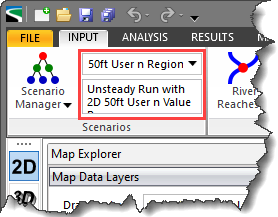
The ribbon menu dropdown combo box allows the user to quickly switch between scenarios. Moving from one scenario to another will cause the contents of the Map View to change to represent the geometry of the selected scenario.
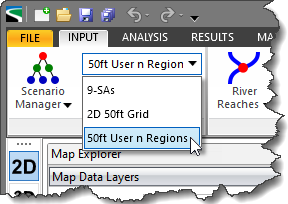
From the Input ribbon menu, click the dropdown combo box arrow of Scenario Manager. It will display four commands: Scenario Manager, Duplicate Current Scenario, Delete Scenarios, and Scenario Summary.
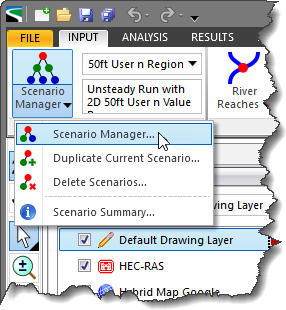
The Scenario Manager dialog box is used to manage the geometry and flow data (i.e., geometry and flow files) associated with the current scenario. In addition, new scenarios, geometry data, and flow data can be created, as well as copied from existing data. Selecting the Scenario Manager command will display the below dialog box.
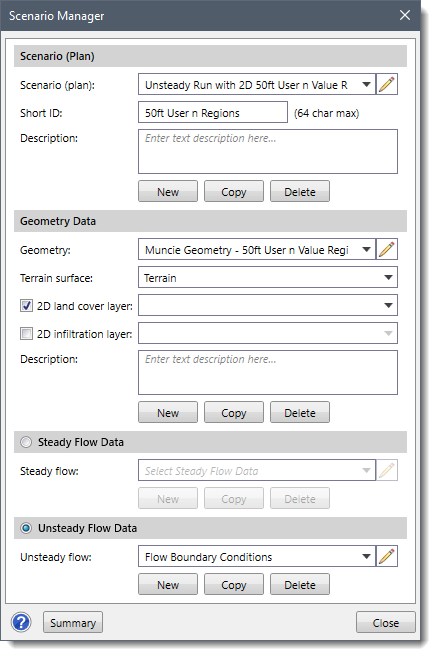
The Scenario Manager dialog box is segmented into the following sections:
Each of these sections contains individual elements that are used to define the corresponding section data. For example, both the Scenario (plan) and Geometry data sections allow the user to provide a description detailing the data. Each section allows the user to name the data. However, scenario (plan) data has both a Long ID and a Short ID for naming its data.
In the Geometry Data section, the user can insert the associated terrain surface from the dropdown.
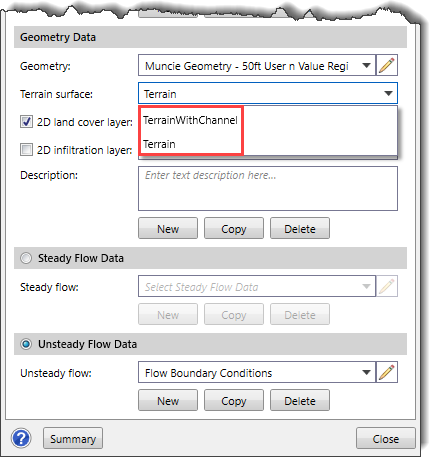
The 2D land cover layer checkbox entry allows the user to associate the project scenario with the land use coverage layer. The available 2D land cover layers of the project will be displayed in the 2D land cover layer dropdown combo box. Refer to this article in our knowledge base to learn more about creating 2D land cover layers.
The 2D infiltration layer checkbox entry allows the user to associate the project scenario with the 2D infiltration layer. The available 2D infiltration layers of the project will be displayed in the 2D infiltration layer dropdown combo box. Refer to this article in our knowledge base to learn more about computing infiltration layers.
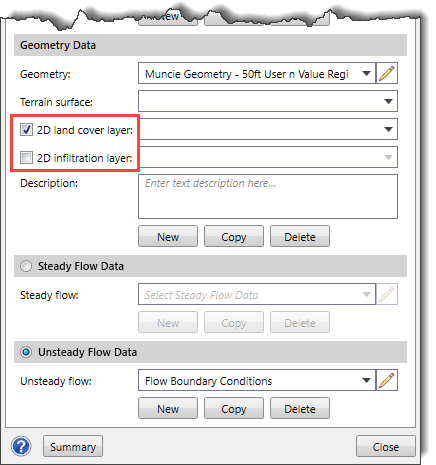
To define the steady or unsteady flow data, the user can enable either the Steady Flow Data or Unsteady Flow Data radio button for the selected scenario.
In the Scenario Manager dialog box, clicking on the [Summary] button will display an informational dialog box that provides a detailed overview of the project: number of scenarios (plans), number of geometry definitions, number of flow definitions, and details of the current plan (such as Element Details, Boundary Conditions, Defined Flows, and Storage Area Elevations).
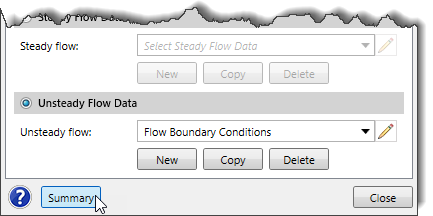
Alternatively, the user can view the scenario summary by selecting the Scenario Summary command from the list of Scenario Manager dropdown commands.
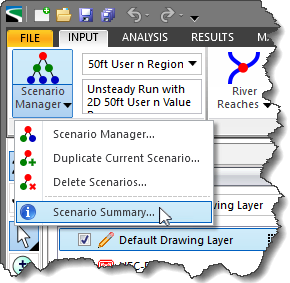
To learn more about the Scenario Summary command, refer to this article in our Knowledge Base.
The Duplicate Current Scenario command makes an identical copy of the current scenario (plan). The user can elect to make a copy of the current geometry and steady flow data. This is helpful when the user needs to create different alternative designs for comparison — when comparing different bridge opening designs, for example.
To learn more about the Duplicate Current Scenario command, refer to this article in our Knowledge Base.
The Delete Scenarios command allows the user to select which plans, geometries, and flow data to remove from the HEC‑RAS project. This is helpful in order to remove data that is no longer relevant to a project or planned for inclusion in a reviewing agency project submittal. In addition, this command compresses the database, removing data no longer in use and reducing the project file size.
To learn more about the Delete Scenarios command, refer to this article in our Knowledge Base.
GeoHECRAS can perform analysis on multiple scenarios at the same time. This is useful, for example, when an existing bridge’s flow regime is compared to a proposed replacement bridge’s analysis. A scenario would consist of selecting the flow data and one of the geometry data. Computations on the multiple plans can then be performed sequentially (one immediately after the other) using the Multiple Scenarios command.
Note that the software provides separate Multiple Scenarios command for steady and unsteady flow models.
To learn more about the Multiple Scenarios command, refer to this article in our Knowledge Base.
After the scenario computations have been performed, the software can display the associated results using the following output parameters:
To view the output results, select the Profile Plots command icon from the Results ribbon menu.
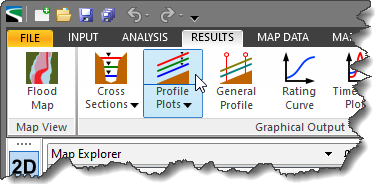
Alternatively, select the Profile Plot command from the Profile Plots dropdown menu.
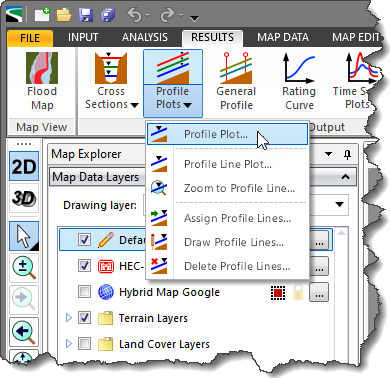
The Profile Plot window will be displayed. From the Profile Plot window, select Plans from the Options menu. The Plan Selection dialog box will be displayed and the user can then select the scenarios (or plans) to display.
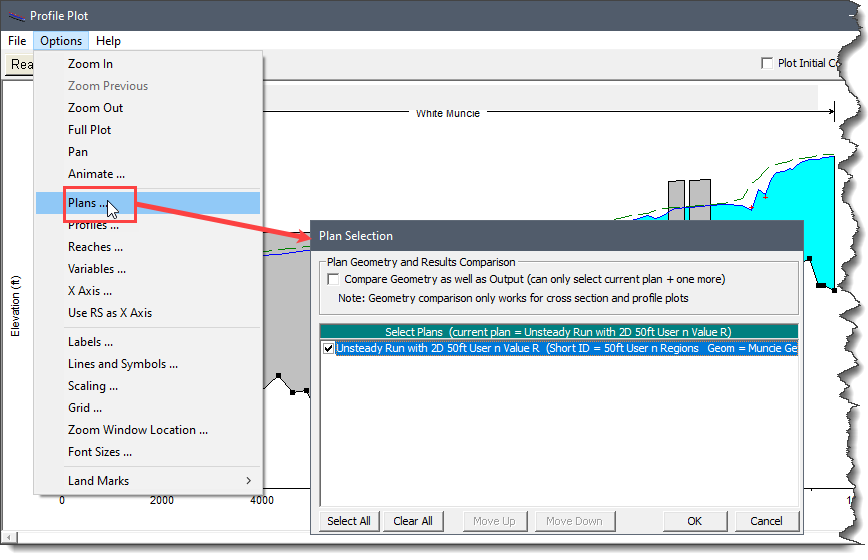
 1-800-301-02-955
1-800-301-02-955
 608-729-5100
608-729-5100
(US and Canada)
 [email protected]
[email protected]
 +1 608-729-5100
+1 608-729-5100
CivilGEO India
Graphix Tower, A-13 A
3rd Floor, Sector 62
Noida, Uttar Pradesh 201309
IndiaTel:
1-800-301-02-955 or
+91 022-3831-8601
CivilGEO United States
8383 Greenway Blvd
6th Floor
Middleton, WI 53562
USATel:
608-729-5100 or
800-488-4110
Copyright © CivilGEO, Inc. All rights reserved. The CivilGEO logo, “GeoSTORM”, “GeoHECHMS”, “GeoHECRAS”, and “Ready To Engineer” are registered trademarks of CivilGEO,Inc.
All other brands, company names, product names or trademarks belong to their respective holders.
We use cookies to give you the best online experience. By agreeing you accept the use of cookies in accordance with our cookie policy.
When you visit any web site, it may store or retrieve information on your browser, mostly in the form of cookies. Control your personal Cookie Services here.
The ZoomInfo WebSights snippet drops three cookies to track Unique Visits:
1. _pxhd - Related to the Perimeter X security layer (Perimeter X isused to prevent bot attacks).
2. _cfduid - Related to the CloudFlare security layer (CloudFlare is the Network Security protocol that ZoomInfo uses to orchestrate the rate limiting rules).
3. visitorId - This is how WebSights identifies recurring visitors








